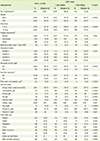Abstract
Figures and Tables
Table 1

*Unweighted sample size; †Sugar-sweetened beverage; ‡χ2 tests were used for each variable to examine differences across categories; §Measured weight and height were used to calculate body mass index (BMI). Underweight was defined as BMI < 5th percentile, normal weight was defined as BMI ≥ 5th to < 85th percentile; overweight was defined as BMI ≥ 85th to < 95th percentile; and obesity was defined as BMI ≥ 95th percentile based on age- and gender- specific reference data from the Korean growth charts; ∥Physical activity ≥ 20 minutes/day at least 3 days during previous 7 days; ¶During this last year, have you ever been received any nutrition education?; **Usually, how many cups of plain water did you drink a day?
Table 2

*Sugar-sweetened beverage; †Model 1 didn't include all variables of study. Reference category included subjects who drank SSBs ≥ 300 ml/day; ‡Model 2 included all variables of study. Reference category included subjects who drank SSBs ≥ 300 ml/day; §Significant finding based on the 95% Confidence Interval (CI) ; ∥Measured weight and height were used to calculate body mass index (BMI). Underweight was defined as BMI < 5th percentile, normal weight was defined as BMI ≥ 5th to < 85th percentile; overweight was defined as BMI ≥ 85th to < 95th percentile; and obesity was defined as BMI ≥ 95th percentile based on age- and sex-specific reference data from the Korean growth charts; ¶< 125% of Energy Efficiency Ratio (EER) and ≥ 125% of EER according to the Korea Centers for Disease and Control (KCDC)'s value that was reported Korea Health and Nutrition Examination Survey (KNHANES) report; **Usually, how many cups of plain water did you drink a day?; ††Fruit and vegetable intake categories were identified those who met the recommended intake and those who did not meeting fruit and vegetable intake guideline according to the WHO recommendation (400 g/day); ‡‡Physical activity ≥ 20 minutes/day at least 3 days during previous 7 days.
Table 3

*Sugar-sweetened beverage; †Model included all variables of study. Reference category included subjects who drank SSB ≥ 300 ml/day; ‡Measured weight and height were used to calculate body mass index (BMI). Normal weight was defined as BMI ≥ 5th to < 85th percentile, overweight was defined as BMI ≥ 85th to < 95th percentile, and obesity was defined as BMI ≥ 95th percentile based on age- and sex- specific reference data from the Korean growth charts; §Significant finding based on the 95% Confidence Interval (CI); ∥< 125% of Energy Efficiency Ratio (EER) and ≥ 125% of EER according to the Korea Centers for Disease and Control (KCDC)'s value that was reported Korea Health and Nutrition Examination Survey (KNHANES) report; ¶Usually, how many cups of plain water did you drink a day?; **Fruit and vegetable intake categories were identified those who met the recommended intake and those who did not meeting fruit and vegetable intake guideline according to the WHO recommendation (400 g/day); ††Physically active ≥ 20 minutes/day at least 3 days during previous 7 days.




 PDF
PDF ePub
ePub Citation
Citation Print
Print


 XML Download
XML Download